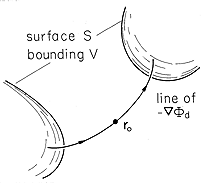We shall show in this section that a potential distribution obeying Poisson's equation is completely specified within a volume V if the potential is specified over the surfaces bounding that volume. Such a uniqueness theorem is useful for two reasons: (a) It tells us that if we have found such a solution to Poisson's equation, whether by mathematical analysis or physical insight, then we have found the only solution; and (b) it tells us what boundary conditions are appropriate to uniquely specify a solution. If there is no charge present in the volume of interest, then the theorem states the uniqueness of solutions to Laplace's equation.
Following the method "reductio ad absurdum", we assume that the
solution is not unique- that two solutions,  a and
a and  b,
exist, satisfying the same boundary conditions- and then show that
this is impossible. The presumably different solutions
b,
exist, satisfying the same boundary conditions- and then show that
this is impossible. The presumably different solutions  a and
a and
 b must satisfy Poisson's equation with the same charge
distribution and must satisfy the same boundary conditions.
b must satisfy Poisson's equation with the same charge
distribution and must satisfy the same boundary conditions.


It follows that with  d defined as the difference in the two
potentials,
d defined as the difference in the two
potentials,  d =
d =  a -
a -  b,
b,

A simple argument now shows that the only way  d can both
satisfy Laplace's equation and be zero on all of the bounding surfaces
is for it to be zero. First, it is argued that
d can both
satisfy Laplace's equation and be zero on all of the bounding surfaces
is for it to be zero. First, it is argued that  d cannot
possess a maximum or minimum at any point within V. With the help of
Fig. 5.2.1, visualize the negative of the gradient of
d cannot
possess a maximum or minimum at any point within V. With the help of
Fig. 5.2.1, visualize the negative of the gradient of  d, a
field line, as it passes through some point ro. Because the
field is solenoidal (divergence free), such a field line cannot start
or stop within V (Sec. 2.7). Further, the field defines a potential
(4.1.4). Hence, as one proceeds along the field line in the
direction of the negative gradient, the potential has to decrease
until the field line reaches one of the surfaces Si bounding V.
Similarly, in the opposite direction, the potential has to increase
until another one of the surfaces is reached. Accordingly, all
maximum and minimum values of
d, a
field line, as it passes through some point ro. Because the
field is solenoidal (divergence free), such a field line cannot start
or stop within V (Sec. 2.7). Further, the field defines a potential
(4.1.4). Hence, as one proceeds along the field line in the
direction of the negative gradient, the potential has to decrease
until the field line reaches one of the surfaces Si bounding V.
Similarly, in the opposite direction, the potential has to increase
until another one of the surfaces is reached. Accordingly, all
maximum and minimum values of  d (r ) have to be located on
the surfaces.
d (r ) have to be located on
the surfaces.

The difference potential at any interior point cannot assume a
value larger than or smaller than the largest or smallest value of
the potential on the surfaces. But the surfaces are themselves at
zero potential. It follows that the difference potential is zero
everywhere in V and that  a =
a =  b. Therefore, only one
solution exists
to the boundary value problem stated with (1).
b. Therefore, only one
solution exists
to the boundary value problem stated with (1).

